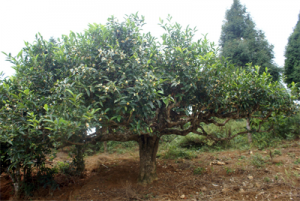 It’s common knowledge that the tea plant comes from China.
It’s common knowledge that the tea plant comes from China.
However, throughout south western Japan there are wild tea plants called Yamacha (山茶, mountain tea).
Is yamacha an indigenous Japanese tea plant?
Solving yamacha’s mystery
As mentioned in the post about history of green tea, there was a cultural exchange in the Nara and Heian periods between Japan and China due to Buddhism.
There are written accounts of Japanese monks traveling to China and then bringing back their knowledge of tea, as well as the tea plants themselves.
The problem is determining the date of when the first tea plant came to Japan, because maybe it did so before the written accounts.
Yamacha differs from Japan’s commercial varieties, and it appears to have been growing for hundreds of yeas. Its leaves aren’t uniform in shape and size, which is another evidence that yamacha hasn’t experienced the continuous selection process by tea farmers.
Yamacha is found close (about a radius of 2 km) from human settlements and farmland. Outside those areas there aren’t any yamacha plants. This means that yamacha had been cultivated in the past, although it doesn’t give clues about its origin.
What the studies say
One study led by professor Hashimoto Minoru stated that probably yamacha tea plants were secretly cultivated during the Kamakura period (1185–1333) in an effort to avoid the high taxes imposed on green tea farmers, and they have remained hidden until now. Hence yamacha isn’t so ancient after all.
Another study in 2002 with DNA analysis concluded that it’s highly likely that yamacha and the modern Japanese cultivars share the same origin.
For more information about tea plants of no identifiable cultivar, please read my post about zairai.
In other words, China is still the motherland of tea, including Japanese tea plants 🙂
Nevertheless, some small tea companies in Japan have been using yamacha and are even cultivating it right now. There’s value in being different.
sources:
http://www.athome-academy.jp/archive/culture/0000000132_all.html






February 11, 2014
Thank you for this great blogpost. This is really useful information for me because it partly explains the Shiiba Yama Cha 椎葉山茶 growing at Jun Chiyabari Tea Garden in Nepal. These plants were brought from seedlings of 山茶 growing wild in the forests of Shiiba village 椎葉村 in Miyazaki.
We have had them for about 10 years now. Although there are just a few of them, I hope to propagate them and spread them all over my tea garden. We are slowly coming to that stage.
February 11, 2014
Hello Lochan
It’s very interesting that you also have yamacha in your tea garden. Teas made from yamacha are very rare.
April 24, 2014
Last week we made some tea from yamacha (mixed with others too though) and it was outstanding. Now we will really have to look at this in more depth. Cheers!